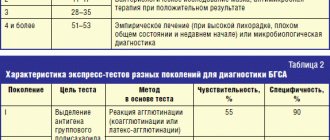In some cases, this disease is treated by a therapist or pediatrician.
Fast passage
Treatment of acute tonsillopharyngitis
Acute tonsillopharyngitis (angina) is an infectious inflammation of the mucous membrane and lymphatic structures of the oropharynx.
The most common causative agent of bacterial tonsillopharyngitis (hereinafter simply pharyngitis) in children and adolescents is group A beta-hemolytic streptococcus (Group A Streptococcus pyogenes, GABHS). GABHS infection accounts for 15-30% of the total number of cases of acute pharyngitis in children aged 5 to 15 years.
The main symptom of GABHS pharyngitis is a sore throat, with no other signs of acute respiratory viral infection (for example, runny nose, conjunctivitis, cough).
In children over 3 years of age, GABHS pharyngitis begins suddenly. In addition to a sore throat, fever, headache, abdominal pain, nausea and vomiting may occur. Upon examination (pharyngoscopy), diffuse inflammation of the mucous membrane of the posterior wall of the pharynx and tonsils, their hyperemia and swelling are diagnosed. A petechial rash on the roof of the mouth or a scarlatiniform rash on the body (an erythematous, papular rash that usually begins in the groin area and then spreads to the trunk and extremities, followed by desquamation) may be present. Enlarged and painful anterior cervical lymph nodes are palpated.
In children under 3 years of age, symptoms of streptococcal infection are usually atypical. Instead of a clearly defined episode of pharyngitis, they may experience prolonged nasal congestion, low fever, tenderness, and enlarged anterior cervical lymph nodes.
Manifestations in infants under 1 year of age include fussiness, decreased appetite and low temperature.
There is no single sign or symptom that reliably identifies strep throat as streptococcal. Only an assessment of the totality of symptoms allows us to talk about the probable presence of GABHS.
Diagnosis of acute tonsillopharyngitis
If there are signs of streptococcal infection, the diagnosis is confirmed by a positive microbiological test (rapid test for the detection of GABHS antigen or a throat swab for GABHS). A test or smear should be performed before starting antibiotic therapy, as even a single dose of antibiotics can lead to a negative result.
Rapid tests for GABHS have a specificity of more than 95% and a sensitivity that varies between 70 and 90%. Given the high specificity and limited sensitivity of the available tests, a positive test for GABHS is sufficient to establish the diagnosis of streptococcal pharyngitis, but a negative test, in turn, does not exclude GABHS infection. Therefore, in a child or adolescent, in case of a negative result of the rapid test, it is necessary to perform a throat smear for GABHS. If the rapid test is positive, then subsequent bacteriological examination is not required.
In adults, with a negative rapid test in a standard situation, subsequent microbiological testing is not required.
A test for GABHS is indicated in the following cases:
- there are signs of acute tonsillopharyngitis (erythema, swelling and/or exudate in the tonsils) or a scarlet rash, but there are no symptoms of a viral infection;
- there was contact with a sick person whose diagnosis of streptococcal infection was confirmed (at home, at school);
- suspicion of acute rheumatic fever or post-streptococcal glomerulonephritis.
GABHS testing is not indicated for children and adolescents with manifestations of a viral infection. From 5 to 21% of children aged 3-15 years are carriers of GABHS, which can be mistakenly perceived as streptococcal rather than viral pharyngitis.
Timely treatment of GABHS in children and adolescents is primarily necessary for:
- prevention of purulent complications and acute rheumatic fever;
- preventing transmission of the disease to others, especially if the patient is in contact with a person who has had a history of an episode of acute rheumatic fever;
- reducing the duration and severity of symptoms of the disease.
Features of the disease
The peripharyngeal ring is a collection of lymphoid tissue, which is an important peripheral organ of the body's immune system. Pathogenic microorganisms that enter the body with food and water are retained in the oral or nasal cavity precisely by the tonsils of the peripharyngeal ring. As a result of the struggle between the body and the infectious agent, a local reaction of the tonsils occurs, which is expressed in increased production of lymphocytes and can lead to tissue inflammation.
Inflammation of the tonsils can also be caused by an internal infection of the body, namely diseases of the oral cavity or ENT organs: caries, sinusitis, rhinitis, otitis media, etc. When the body's immune defense is weakened due to illness or hypothermia, opportunistic microflora found in the growth or nasal cavity can provoke acute inflammation of the tonsils. Factors that provoke pathology are bad habits (smoking and alcohol abuse), diseases of the gastrointestinal tract, working in hazardous working conditions, and unhealthy diet.
The risk group for the disease includes pregnant women, the elderly and children, as well as people with chronic damage to the immune system.
Complications of GABHS-pharyngitis
In most cases, GABHS pharyngitis resolves without complications. Non-purulent complications include acute rheumatic fever, post-streptococcal glomerulonephritis, childhood autoimmune neuropsychiatric disorders associated with streptococcal infection. Purulent complications of streptococcal pharyngitis include necrotizing fasciitis and bacteremia.
The differential diagnosis of GABHS pharyngitis includes both infectious and non-infectious causes of pharyngitis.
The main viral diseases manifested by acute pharyngitis:
- infectious mononucleosis - Epstein-Barr virus (EBV) and cytomegalovirus. More common in adolescents and characterized by fever, severe pharyngitis (which lasts longer than GABHS pharyngitis), anterior and posterior cervical or diffuse lymphadenopathy. Periorbital edema, mild hepatomegaly, and splenomegaly may be present. Patients prescribed ampicillin, amoxicillin (sometimes other antibiotics) may develop a characteristic rash;
- primary HIV infection —may cause an acute retroviral syndrome (similar to infectious mononucleosis) in sexually active adolescents or rarely in sexually abused children. Clinical signs of primary HIV infection include severe cervical or generalized lymphadenopathy and complaints of fever, weight loss;
- herpes simplex virus - pharyngitis caused by the herpes simplex virus, manifested by blistering rashes on the mucous membrane, lips;
- influenza - characterized by fever, cough, headache and myalgia, which occur during seasonal epidemics;
- other viral diseases - enteroviruses, adenoviruses, rhinoviruses, coronaviruses, respiratory syncytial virus, parainfluenza viruses.
The main bacterial causes of pharyngitis:
- streptococci of groups C and G - there is still a debate about the role of these bacteria in the etiology of acute pharyngitis;
- n eisseria gonorrhoeae (gonorrhea) is a relatively rare cause of pharyngitis. Most cases are asymptomatic or symptoms are nonspecific (eg, pharyngeal congestion, swelling or exudate in the tonsil lacunae);
- f usobacterium necrophorum (Lemierre's syndrome) is the cause of most cases of purulent thrombophlebitis of the jugular vein. Clinical signs include strep throat, high fever (39°C), respiratory symptoms, unilateral neck swelling or pain;
- diphtheria - rare in developed countries, but important to consider in patients from endemic areas. Unlike GABHS pharyngitis, which has an acute onset, the onset of diphtheria symptoms usually occurs gradually. A distinctive feature of diphtheria is the formation of a gray filmy coating that adheres tightly to the mucous membrane of the nose and throat, the removal of which leads to bleeding;
- others - tularemia (Francisella tularensis), Arcanobacterium haemolyticum, Mycoplasma pneumoniae.
Non-infectious causes of pharyngitis are diagnosed based on medical history. This may be irritation or dryness of the pharynx, a foreign body (for example, a fish bone), chemical exposure, radiating pain due to dental abscess, acute otitis media.
What type of sore throat is it?
The disease is divided into several types depending on the cause that caused it and the pattern of the disease. To determine the specific type, the doctor examines the patient’s throat.
- Catarrhal. The easiest possible option. With modern methods it can be cured in about 2 days, but without treatment it can develop into a severe form.
- Follicular. Identified by festering follicles. Yellowish bubbles are observed on the membranes of the throat.
- Lacunarnaya. The main symptom is a yellow coating in the gaps.
- Fibrous. The follicles burst and their contents can be seen on the tonsils.
- Herpetic. It is determined by the appearance of bubbles on the tonsils and pharynx.
- Phlegmous. If one of the above-described forms is not treated, a phlegmous, severe variety will occur.
- Ulcerative-necrotic. It appears as dead areas on the tonsils.
Treatment of acute tonsillopharyngitis
Antibiotic therapy is recommended for any patient with symptomatic pharyngitis or tonsillopharyngitis who has a positive rapid antigen or culture test for group A streptococcus.
Empirical treatment is generally not recommended because there is significant overlap between the clinical features of GABHS pharyngitis and nonstreptococcal pharyngitis. Short delays in therapy (eg, while awaiting culture results) do not increase the incidence of complications, including acute rheumatic fever. However, it is unknown whether such treatment delays affect the incidence of other complications (eg, development of peritonsillar abscess).
If clinical suspicion for GABHS pharyngitis is high and test results cannot be obtained quickly, it is advisable to initiate antibiotic treatment while awaiting test results. If the diagnosis is not confirmed, antibiotics should be stopped.
Antibiotic treatment is not recommended for asymptomatic chronic GABHS carriers or for GABHS carriers with signs of acute viral pharyngitis.
Antibacterial therapy
The drug of choice for the treatment of GABHS pharyngitis is penicillin antibiotics. Penicillin is the only antibiotic that has been studied and shown to reduce the incidence of acute rheumatic fever. For complete eradication of GABHS, the duration of the course of antibacterial therapy is 10 days.
Amoxicillin is more preferable for young children. It can be given once daily using an extended-release form (suspension). In several randomized trials, amoxicillin suspension at a standard dose (once daily) was found to be as effective as penicillin taken orally.
In case of allergy to penicillins or poor tolerance, preference is given to cephalosporin antibiotics, lincosamides (clindamycin) and macrolides - the choice of drug depends on the type of allergic reaction to penicillin.
Studies that combined data from more than 5000 adults and children showed no clinically significant difference between cephalosporins, macrolides, or clindamycin compared with penicillin or amoxicillin in the resolution of GABHS tonsillitis symptoms. But no studies have assessed the use of alternatives to penicillin for the prevention of acute rheumatic fever. Thus, penicillin remains the drug of choice whenever possible.
Tetracyclines, sulfonamides and fluoroquinolones should not be used to treat streptococcal pharyngitis due to high resistance and high side effect profile.
Nonsteroidal anti-inflammatory drugs (ibuprofen) or acetaminophen (paracetamol) may be used to relieve fever and pain.
How is acute tonsillopharyngitis treated at the Rassvet clinic?
When diagnosing a sore throat, we always pay attention not only to the pharyngoscopy picture, but also to the presence of signs of a viral infection. This means we do not perform streptococcus tests on all patients with acute pharyngitis.
If there are signs of GABHS pharyngitis, we must perform a rapid test; if indicated, we take material for testing only for GABHS. Confirmation of streptococcal infection helps prevent unnecessary prescription of antibiotics for viral pharyngitis.
We do not prescribe throat swabs for flora. Streptococcal infection is one of the few causes of tonsillopharyngitis for which treatment with antibiotics is recommended. To this day, the need for antibacterial therapy for most other pathogens remains controversial. Other bacterial infections that strictly require treatment include diphtheria and gonorrhea.
We do not order an ASLO test on the first day of illness (ASLO - antistreptalizin-O, antibodies produced in response to the toxin of group A beta-hemolytic streptococcus). ASLO increases only 10-20 days after the onset of streptococcal infection. There is also no point in monitoring it every week, since this marker begins to decrease 3-5 weeks after the illness, but its levels can be higher than normal for up to a year.
We understand that the main goal of antibiotic therapy for streptococcal pharyngitis is to prevent complications. Treatment with antibiotics has been shown to reduce the severity of symptoms and speed recovery in patients with streptococcal pharyngitis, but even without antibiotic therapy, in most cases, symptoms resolve within three to five days.
We do not treat any plaque in the throat with antibiotics, since their presence does not equal streptococcal tonsillitis, nor vice versa.
Classification of the disease
Inflammatory pathology of the tonsils varies:
- by type of pathogen, can be bacterial, viral or fungal in nature;
- by the nature of the course - acute or chronic;
- according to the clinical picture - catarrhal, follicular or lacunar.
Sore throat can be primary (simple), which occurs when a bacterial infection penetrates, secondary, which occurs against the background of other diseases of the body, and also specific, caused by the action of a specific agent.
General recommendations
Rest, adequate fluid intake, gentle nutrition, it is advisable to avoid irritation of the respiratory tract. Most patients can return to work or school after completing one full day of treatment, provided their general health allows it.
The recommendation is based on a small cohort study in children that showed that about 80% of patients with culture-proven streptococcal pharyngitis were no longer infectious within 24 hours of starting therapy.
A follow-up rapid test for streptococcus after treatment is usually not required and is indicated only in the following cases:
- patients with a history of acute rheumatic fever;
- patients who became ill during an outbreak of acute rheumatic fever or post-streptococcal glomerulonephritis;
- patients who became infected from close relatives (in the family).
If the control test is positive, it is recommended to repeat the 10-day course of antibiotic therapy. For the second course of treatment, an antibiotic is selected that is more stable against beta-lactamase degradation.







